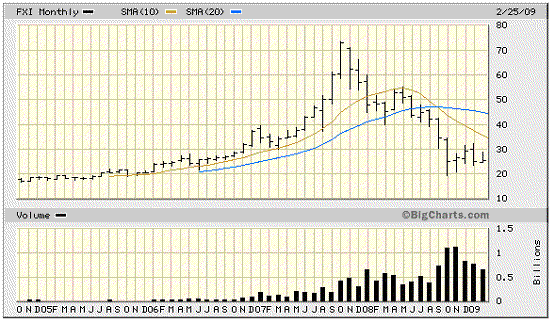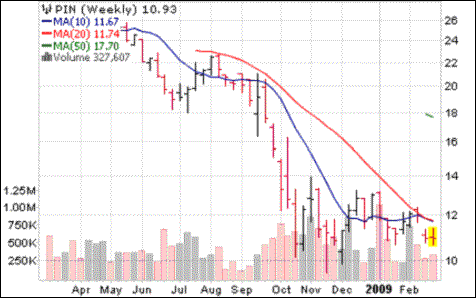| China And India ETFs |
| By Price Headley |
Published
02/28/2009
|
Stocks
|
Unrated
|
|
|
|
China And India ETFs
The benefits of investing in exchange-traded funds (ETF) have long been lauded on the Street (liquidity, low expense ratios, and diversification of a portfolio are just a sampling of the benefits). You can invest in ETFs that track Gold, Oil, and the major indices; but did you know that you can invest in ETFs that follow specific countries and regions of the world? Well, you can. And options are a great way to use leverage to trade ETFs with little cash outlay.
Heading into 2009, several experts were touting the potential in China and India - especially with the American economy in the tank. Why these two countries? Investors are attracted to the long-term potential of the two countries, including political reform in China and a burgeoning democracy in India. These markets are suitably named emerging markets, as the countries are still developing and have markets with short operating histories.
Let's begin by taking a look at a couple of rather popular Chinese ETFs. The first is the iShares FTSE/Xinhua China 25 Index Fund (FXI). According to iShares, FXI "seeks investment results that correspond generally to the price and yield performance ... of the FTSE/Xinhua China 25 Index." Slightly more than 47% of this ETF is wrapped up in financials, with 17.3% comprised of telecom.
With China becoming the U.S.'s largest creditor (with $696.2 billion of Treasury Bills), there is some logical appeal to investing in FXI. That said, the ETF's performance has dragged along with the entire world's economy. FXI's near-term high took place in October 2007, and the shares have slumped since. Nevertheless, the ETF continues to outperform the S&P 500 Index (SPX).
FXI has dropped from its October 2007 high atop the 70 level to its current perch in the 30 region. The problem the stock faces is overhead resistance from its 10-month moving average. This trendline has provided resistance since late 2007, and appears ready to continue in this role.
FXI Monthly Chart

The intermediate-term outlook for FXI isn't much better, as it faces considerable resistance from its 10- and 20-week moving averages. That said, it does appear that there is support in place at the 25 level. Will this level provide a springboard for the ETF? Only time will tell.
This ETF is just one of the 10 that tracks China in which you can invest, make sure to research all of them and determine how you will invest in this emerging market.
Let's turn to another emerging area, India. As with China, there are many reasons to invest in India, some of the reasons include: the large population, the opportunity for major moves in the market, and a rather solid track record of cutting-edge technology and innovation in a number of sectors including technology and telecommunications
There aren't nearly as many ETFs tracking India as there are China, but there are still choices. We are going to take a look at arguably the most popular India-based ETF, the PowerShares India Portfolio ETF (PIN).
As with FXI, PIN is struggling along with the entire global economy. The stock is caught in a rather tight trading range between the 10 and 14 regions. Directly overhead lurk PIN's 10- and 20-week moving averages, which have provided double-barreled resistance since August 2008.
PIN Weekly Chart

If you are leery of investing in a specific country's economy, there are other options. A large number of ETFs focus on emerging markets. Among this basket of funds are the Claymore Frontier Markets ETF (FRN), the iShares MSCI Brazil Russia India China (BRIC) Index Fund (BKF), and the iShares MSCI Emerging Markets Index Fund (EEM).
The bottom line is that the long-term outlook for "Chindia" (China/India region) is very positive, due to the gigantic demographic growth potential of their middle class. But shorter-term, one should utilize short-term technical indicators and charts to determine the next move for these volatile markets.
Price Headley is the founder and chief analyst of BigTrends.com.
|